
The Short S17 Kent flying boat Scipio crashed on landing in Mirabella Bay, Crete on 22 August 1936. It was carrying mail on the Alexandria - Brindisi leg of the Imperial Airways Australia - England airmail service. On 5 December 1937, the Short S23 Empire flying boat Cygnus crashed while taking off from Brindisi. On 27 November 1938, the Calpurnia crashed while landing at Lake Ramadi in Iraq. On 13 March 1954, the Lockheed Constellation Belfast crashed on landing at Singapore.
Scipio crash
Mail left New Zealand in early August to connect with flight IW470 that had left Brisbane on 12 August [2]. On August 22, the Scipio left Alexandria bound for Brindisi with the first stop being at Mirabella in Crete. Two passengers were killed in the crash when the plane sank in Mirabella Bay after landing in rough seas.
The following cover was amongst the salvaged mail. The stamps have floated off, but the letters N Z can be seen in the remains of the postmark.
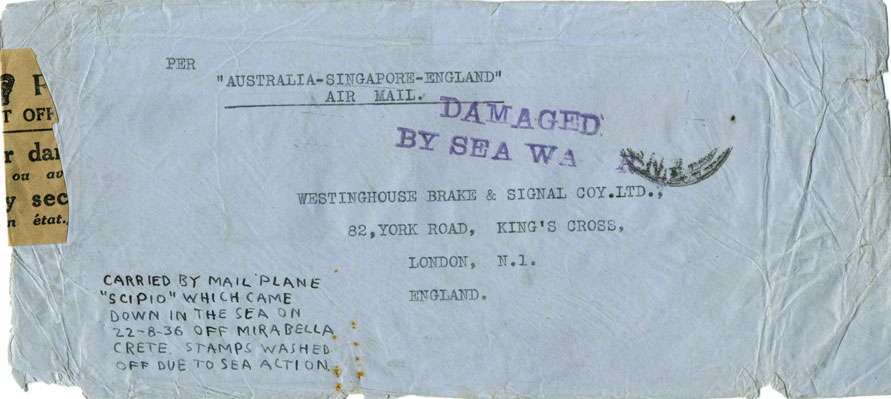
The salvaged mail was taken to Athens. Some of the mail was flown directly in London while the remainder was sent by rail to Paris and flown to London from there. The arrival dates were 25 and 27 August respectively.
The cachet DAMAGED BY SEA WATER was applied in London. A large number of different cachets exist. (Sanford [1] shows examples of a dozen applied in London together with others applied at other European destinations.) The cachets are usually in black or purple.

An official Post Office strip of brown gummed paper was attached to secure the letter. It has a London datestamp showing 27 August.
Cygnus crash
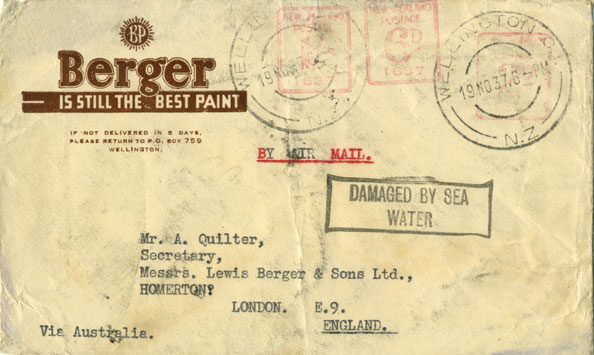
From October 1937, the service between Karachi and London was operated by Short S23 Empire flying boats.
The S23 flying boat Cygnus left Karachi on 2 December and crashed when taking off from Brindisi in Italy on 5 December. A steward and a passenger were killed.
This cover is postmarked 19 November 1937 in Wellington and joined flight IW 604 that had left Brisbane on 25 November. It is one of 8,000 from New Zealand salvaged after spending several hours underwater. The cachet DAMAGED BY SEA WATER was applied in London. There is a faint handstamp on the front (presumeably applied by the receiving company) with the date 15 December.
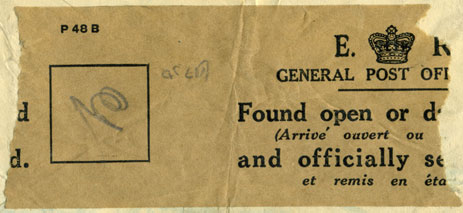
Most covers had the stamps washed off, but as the cover has a meter franking of three 6d values, the cover is complete if rather crumpled.
An official Post Office strip of brown gummed paper was attached
to secure the letter.
It has the royal insignia E R indicating Edward VIII although
he had abdicated a year earlier.
Other cachets

According to Sanford [1], this cachet was applied in London to mail from several different crashes including both Scipio and Cygnus. It is notable for its unusual spelling of Airplane.
The date on the postmark has been washed off along with the stamps although, as the cover has an airmail label, the flight would be before the introduction of the Empire Air Mail Scheme which rules out the crash of the Centurion at Calcutta in June 1939.
The cover has a clear NZ in the remains of the postmark
and so the crash of the Courtier at Athens on 1 October
1937 is also ruled out as none of its mail originated in
Australia or New Zealand.
Crash of the Calpurnia, 1938
Flying was still dangerous and there were several crashes from which covers were salvaged. The one from which the largest number of covers is still available is the crash of the Calpurnia in Iraq on 27 November 1938.
On the 23 and 24 November 1938, Short S23 Empire flying boats left the UK for Alexandria where Australian and New Zealand mail from both flights was loaded on the Empire flying boat Calpurnia.
The flight from Alexandria was to Tiberias on the sea of Galilee and from there to Lake Habbaniyah near Baghdad. On November 27, in the dark and during a sandstorm, the Calpurnia crashed on landing in Lake Ramadi (12 miles from Lake Habbaniyah) killing the four flight crew: pilot Captain Attwood, First Officer Spottiswood, Radio Operator Bayne-Rees and Flight Clerk Ubee. Two passengers and the stewardess survived [1].
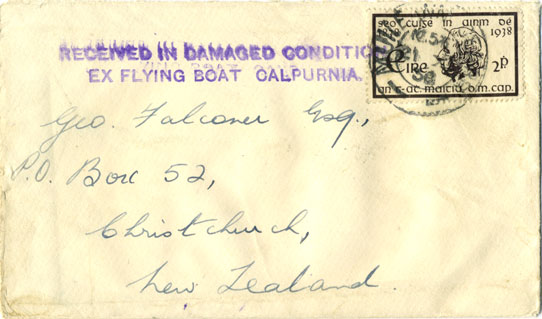
The RAF retrieved a large part of the mail from the water including 60 of the 69 mailbags for New Zealand. An attempt was made to dry the mail before it was sent to Sydney. The New Zealand mail was sent on to Auckland where it was dried further.
Great efforts were made to deliver the mail and to decypher washed out handwriting. Several different cachets were applied in New Zealand: at Auckland, Christchurch and three at Wellington. The example cover has one of the Wellington cachets.
The cover was posted in Ireland and has a 21 November postmark. It would have been carried to Southampton to join the Imperial Airways flight on either 23 or 24 November.
The first mail from the flight arrived in Auckland on 19 December with further mail arriving over the next three weeks. A manuscript on the back states that the above cover was received in Christchurch on 31 December.
Many of the covers had the stamps washed off and some New Zealand post offices applied postage due markings which was against UPU regulations [1].
Crash of the Belfast, 1954
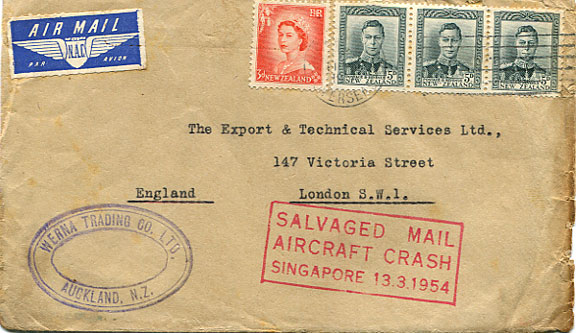
On 13 March 1954, the Lockheed Constellation Belfast crashed on landing at Singapore. 33 people were killed and the Constellation was destroyed by fire.
Most of the mail on board, mostly from New Zealand and Australia for the Uk was saved although partly burnt. This cover is slightly singed and has the usual cachet. The mail was flown to London, leaving Singapore on 18 March [3, 4].
The mail is franked with 1s 6d, the same rate as it was twenty years earlier in 1934.
All scans were made by the author.
Information on this page is taken from:
Airmails of New Zealand, volume 2 (1986) compiled by
Douglas A Walker, and
The New Zealand Airmail Catalogue, (2nd Edition, 1994)
by James Stapleton.
Both are published by the
Air Mail Society of New Zealand
[1] K C Sanford, Air Crash Mail of Imperial Airways and Predecessor
Airlines, published by Stuart Rossiter Trust Fund, 2003.
[2] Aircraft Movements on Imperial Airways' Eastern Route,
Vol 1, 1927 - 1937, Peter Wingent, Winchester 1999.
[3] Airmails of New Zealand, volume 3, R.M.
Startup, 1997,
Air Mail Society of New Zealand
[4] New Zealand Wreck Mails, B R Peace, The Kiwi, vol 21, pp 118-132,
September 1972.